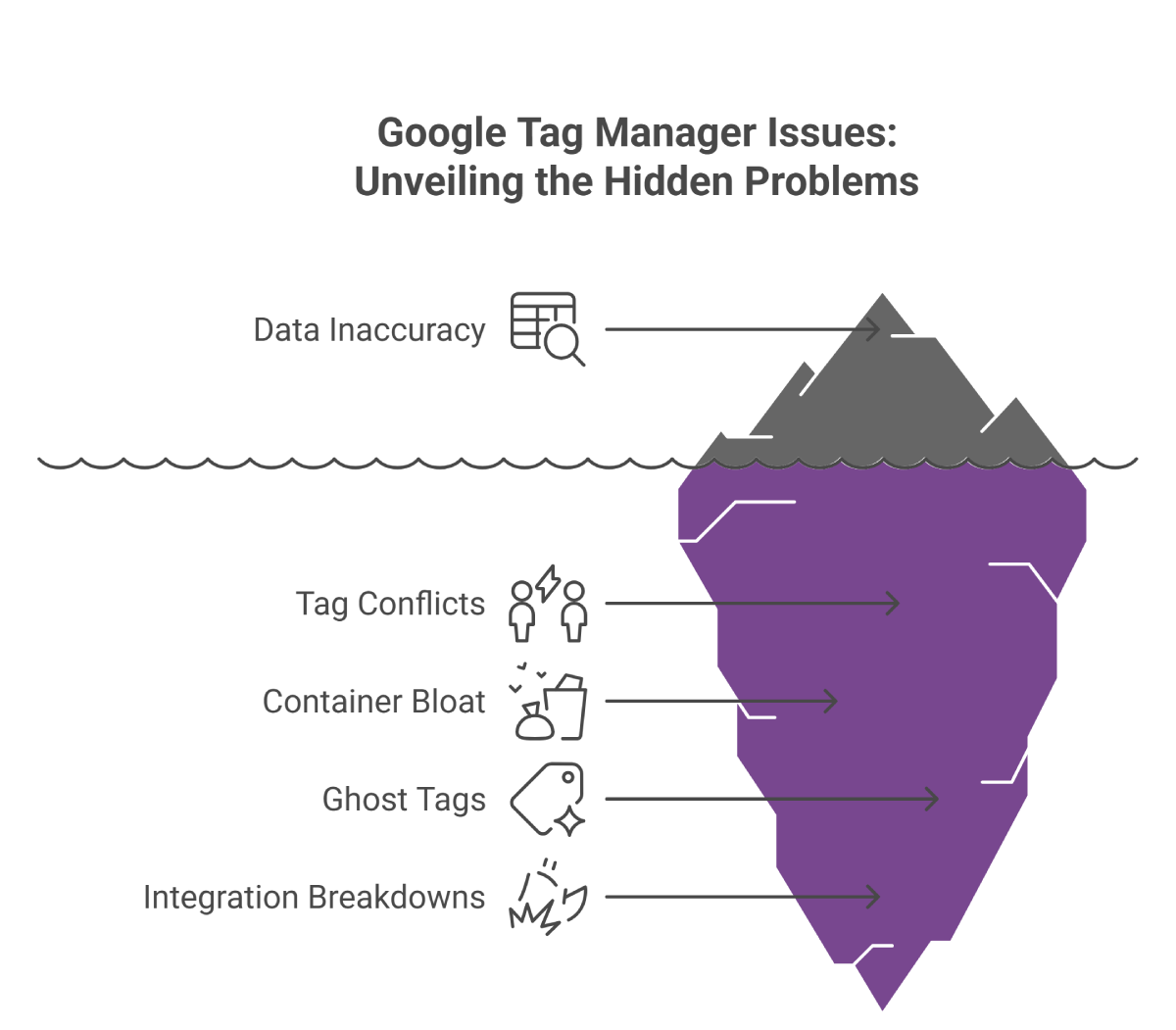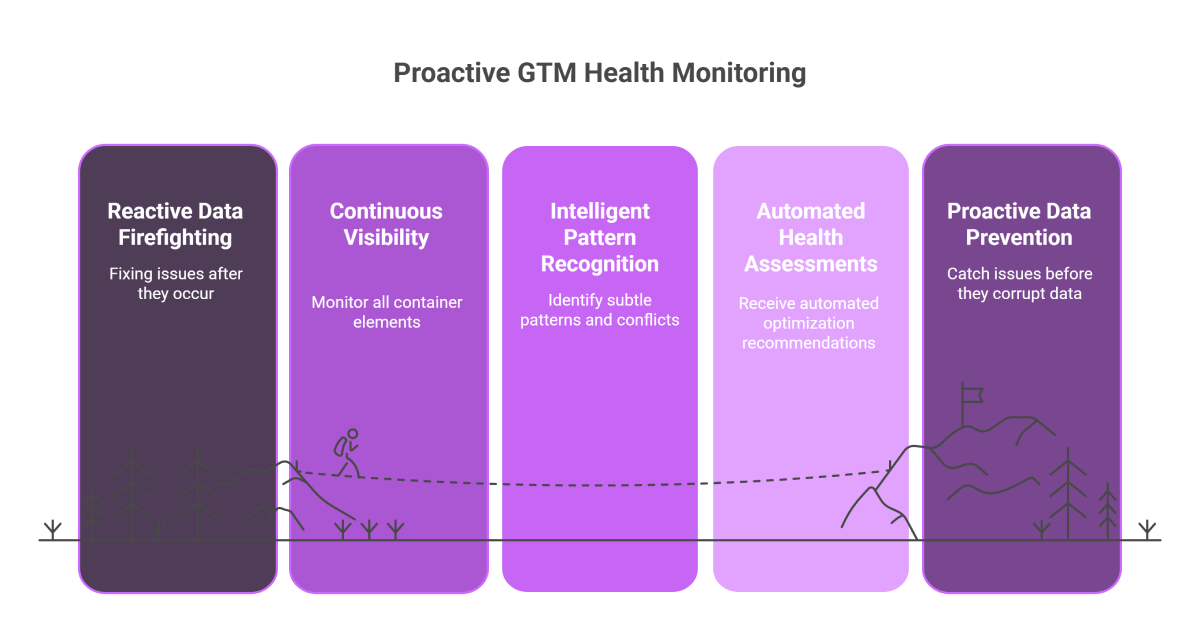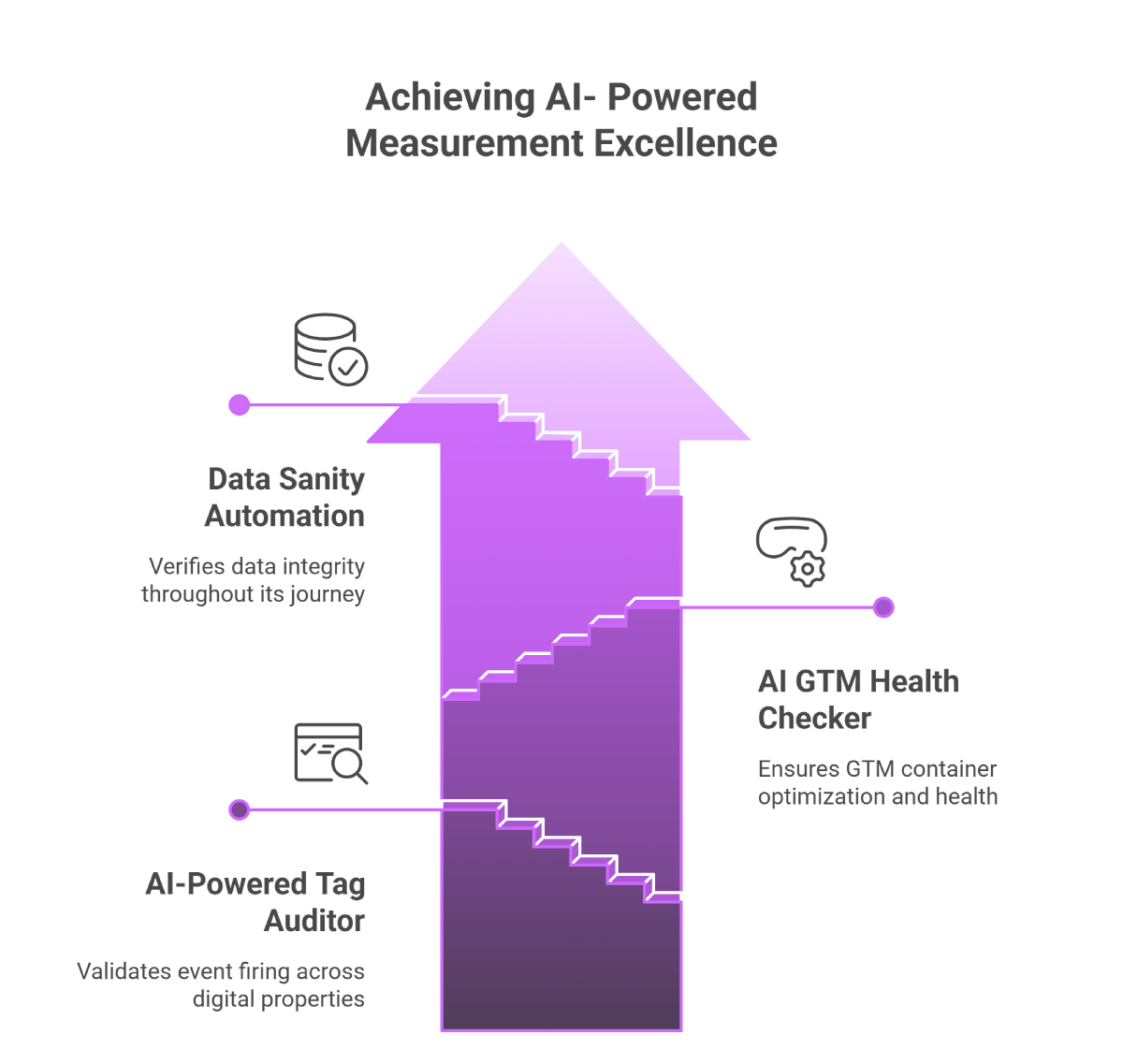You validated every tag. Your GA4 dashboard looks clean. Yet, something feels off. The data doesn’t quite add up – and you can’t figure out why.
Most businesses think validating GA4 is enough. They run periodic checks, review their reports, and assume their measurement foundation is solid. But here’s what they’re missing: GA4 data integrity actually starts before data is even collected – inside your Google Tag Manager.
Your GTM container is the foundation of everything. When it’s compromised, every downstream validation effort becomes meaningless. Even perfect GA4 setups can’t compensate for a broken GTM foundation. This is where automated data quality checks become essential – and where understanding container health monitoring transforms how organizations maintain measurement integrity.
If you missed Part 1 of this series on fixing GA4 data corruption at the source, you can read it here: From Broken Signals to Trusted Insights: How Agentic AI Secures Data Collection
Why GTM Health Is Critical for Accurate Data
Google Tag Manager is the control center of your data collection. It determines when tags fire, what information gets passed along, and how your tracking codes interact across your digital properties. When GTM is healthy, it’s incredibly powerful. When it’s not, it silently sabotages your data quality.
Think of your GTM container like a car. When it’s new, everything runs smoothly. But without regular maintenance, small issues compound. The engine gets less efficient, parts wear down, and one day you’re stranded, wondering why you didn’t catch the warning signs earlier.
The cascading failures caused by poor GTM container health:
- Marketing teams allocate millions based on incomplete tracking
- Analytics teams waste hours troubleshooting mysterious data gaps
- Websites load slowly because of bloated tag setups
- Compliance teams face regulatory risks from misconfigured tracking
What starts as a simple container with a dozen tags evolves into a complex ecosystem with hundreds of elements. Without continuous data monitoring, problems multiply silently while you’re completely unaware. By the time issues surface in your reports, weeks of corrupted data have already influenced business decisions.
Common GTM Health Issues That Undermine Data Quality
Let’s explore the most common problems that silently destroy your data quality automation efforts.
Tag Conflicts
Imagine two people trying to squeeze through the same doorway simultaneously. That’s what happens with tag conflicts in GTM. Multiple tags fire at the same time or in the wrong order, interfering with each other.
Consider this scenario: Your e-commerce conversion tag fires before product data loads. Transactions get recorded, but you have no idea which products drove revenue. Your merchandising analytics become useless.
These conflicts emerge gradually as containers grow. Regular Google Tag Manager audit processes become critical for catching these issues before they snowball.
Ghost Tags
“Ghost tags” are perhaps the most common issue discovered when auditing Google Tag Manager containers. These are tags created for specific campaigns or tests that should have been removed – but weren’t.
The issue: These abandoned tags keep firing indefinitely. They collect data nobody uses, sometimes break newer implementations, and always add unnecessary weight to your container. Teams often have zero visibility into which tags serve a purpose and which are digital deadweight.
Container Bloat
Over time, GTM containers accumulate digital clutter. Old campaign tags, unused tracking codes, forgotten configurations – they all pile up.
The impact: Every unnecessary tag slows your website. Users don’t wait for slow pages – they bounce. Higher bounce rates mean less data collected, undermining the very analytics you’re trying to improve. Without automated data quality management, this bloat keeps growing unchecked.
Integration Breakdowns
Your GTM container must connect properly with GA4, advertising platforms, and other tools. When these connections break or get misconfigured, you develop measurement blind spots.
Without continuous GTM container health monitoring, these failures go undetected for weeks or months. By the time someone notices something looks off, corrupted data has already influenced major decisions.
If GTM clutter, tag conflicts, or ghost tags sound familiar, this guide on automated audits will help. Read: AI-Powered Tag Auditor
Why Manual GTM Audits Fall Short
Most organizations handle GTM maintenance through periodic manual audits – maybe quarterly if they’re disciplined, maybe just when something breaks. A specialist reviews the container, tests some tags, documents issues.
The fundamental limitations:
- You Can’t Check Everything: Even thorough manual reviews barely scratch the surface. Manual processes typically examine less than 5% of potential issues. You’re operating blind on 95% of your container.
- You’re Always Playing Catch-Up: Manual audits show what was wrong last week. By the time you finish documenting and fixing issues, new problems have emerged. You’re perpetually behind.
- It Depends on Who’s Checking: Audit quality varies significantly. Different specialists can reach completely different conclusions about identical containers. This inconsistency undermines your data quality automation strategy.
- It Consumes Valuable Time: Manual Google Tag Manager audit processes consume days of specialist time-time that could be spent on strategic improvements instead of hunting for problems.
Moreover, manual approaches provide no continuous data monitoring. You get a snapshot of a moment in time, not ongoing visibility. Modern businesses can’t operate on quarterly check-ups when campaigns launch daily and tracking requirements change constantly.
Manual audits weren’t built for the pace of modern marketing. Here’s a smarter way to maintain accuracy 24/7. Read: Beyond Manual Checks: How Data Sanity Automation Protects GA4 Integrity
Understanding AI-Powered GTM Health Monitoring
What if you could examine every element of your GTM container continuously – identifying issues before they corrupt your data? That’s the fundamental question driving modern approaches to container health management.
AI-powered health monitoring represents a shift from periodic audits to continuous intelligence. Rather than checking a fraction of your container occasionally, these systems examine everything constantly – learning patterns, identifying anomalies, and flagging potential issues before they impact data collection.
The underlying principle: Prevention beats remediation. Understanding container health in real-time enables proactive maintenance rather than reactive firefighting.
Assess your current GTM health and uncover hidden issues, we can walk you through it → Book a free consultation
1. Complete Container Visibility
Modern monitoring systems examine every element continuously – every tag, trigger, variable, and connection. Unlike manual processes that sample configurations, automated data quality checks achieve 100% coverage.
What continuous monitoring reveals:
- All tags and their firing status in real-time
- Potential conflicts between tags before they cause problems
- Container size and its performance impact
- Unused elements cluttering your setup
- Connections to downstream platforms
- Overall GTM container health metrics
Nothing slips through the cracks. You gain complete visibility that manual Google Tag Manager audit processes simply cannot match.
2. Intelligent Pattern Recognition
Advanced systems don’t just flag obvious errors – they identify subtle patterns that indicate emerging problems. By analyzing how tags interact, when they fire, and what data they pass, these systems detect conflicts before they cause measurement failures.
For instance, the system might notice that a new tag’s firing pattern overlaps with existing tags in ways that could create race conditions. Rather than waiting for data corruption to surface in reports, you receive early warnings about potential issues.
This proactive approach prevents measurement failures rather than documenting them after damage occurs. That’s data quality automation at its most effective – catching problems before they become problems.
3. Automated Health Assessments
Instead of manual spreadsheet reviews, modern systems provide automated health assessments. They identify ghost tags and unused elements, calculate container efficiency metrics, and recommend specific optimizations.
It’s analogous to having continuous code review for your measurement infrastructure – systematic evaluation that catches issues human reviewers might miss. Your container stays lean and performant without constant manual effort.
4. Real-Time Integration Monitoring
The system continuously validates connections between GTM and all downstream platforms. If a connection breaks or degrades, you know immediately – not weeks later when numbers look unusual.
This continuous monitoring ensures your tag management optimization efforts actually deliver results rather than creating new blind spots.
The Business Impact
Organizations implementing AI-powered solutions to automate data quality experience measurable improvements across operations.
1. Shift From Reactive to Proactive
GTM audit processes that previously consumed 6-8 hours now complete automatically in minutes. More importantly, the shift from periodic audits to continuous monitoring fundamentally changes how teams approach container health. Specialists work on what actually moves the needle – strategy, optimization, growth initiatives.
2. Earlier Issue Detection
Automated data quality checks catch issues before they impact collection. Problems get resolved during scheduled maintenance rather than emergency sessions. You shift from reactive firefighting to proactive prevention – maintaining GA4 data integrity without constant crisis management.
3. Measurable Performance Improvements
Optimized containers mean faster page loads and better user experiences. Organizations see measurable Core Web Vitals improvements after implementing systematic cleanup. Users stay longer, convert more often, and provide more behavioral data.
4. Continuous Compliance Monitoring
Automated monitoring helps ensure tracking complies with evolving privacy regulations. You can quickly identify and address potential compliance issues before they become legal problems. This automated data quality management provides ongoing compliance visibility without constant manual oversight.
The 5-Pillar Measurement Excellence Framework
The complete picture of tag management optimization becomes clear through a comprehensive five-pillar approach:
Pillar 1: AI-Powered Tag Auditor validates events fire correctly across your properties, confirming implementation quality in real-world conditions.
Pillar 2: AI-Powered GTM Health Checker ensures your container is optimized at the source, maintaining GTM container health continuously.
Pillar 3: Data Sanity Automation verifies data maintains integrity throughout its journey into GA4, ensuring what lands in reports is trustworthy.
Pillars 4 & 5: Two additional elements complete the framework, addressing advanced aspects of analytics infrastructure and continuous optimization.
Together, these create comprehensive protection for data integrity – from configuration through collection to validation. This integrated approach represents a fundamental shift. Instead of waiting for problems, you continuously monitor health at every stage and catch issues before they cause damage.
Your Path Forward
The evolution of Google Tag Manager audit processes points toward automation, intelligence, and continuity. Organizations adopting these approaches gain measurable advantages – faster websites that convert better, more reliable tracking that supports evidence-based decisions, and greater confidence in measurement foundations.
Manual audits will always have coverage gaps. Reactive troubleshooting will always cost more than proactive prevention. The question isn’t whether GTM health issues exist in your container – they likely do.
The real question: Will you discover and address them before they compromise your data quality and impact business decisions?
Take the first step toward measurement excellence. Schedule a Free Consultation and Explore AI-Powered GTM Health Checker
Understanding your container’s actual health state, rather than assuming it’s fine – represents the first step toward building truly reliable measurement infrastructure.






